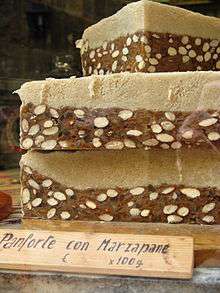Panforte
|
Traditional style panforte | |
| Type | Fruitcake |
|---|---|
| Place of origin | Italy |
| Region or state | Tuscany |
| Main ingredients | Nuts, honey, sugar, fruits, spices |
| Variations | Panpepato |
|
| |
Panforte is a traditional Italian dessert containing fruits and nuts, and resembles fruitcake or Lebkuchen. It may date back to 13th century Siena, in Italy's Tuscany region. Documents from 1205 show that panforte was paid to the monks and nuns of a local monastery as a tax or tithe which was due on the seventh of February that year. Literally, panforte means "strong bread" which refers to the spicy flavour. The original name of panforte was "panpepato" (peppered bread), due to the strong pepper used in the cake. There are references to the Crusaders carrying panforte, a durable confection, with them on their quests, and to the use of panforte in surviving sieges.
The process of making panforte is fairly simple. Sugar is dissolved in honey and various nuts, fruits and spices are mixed together with flour. The entire mixture is baked in a shallow pan. The finished cake is dusted with icing sugar. Commercially produced panforte often have a band of rice-paper around the edge.
Currently there are many shops in Italy producing panforte, each recipe being their jealously guarded interpretation of the original confection and packaged in distinctive wrapping. Usually a small wedge is served with coffee or a dessert wine after a meal, though some enjoy it with their coffee at breakfast.
In Siena—which is regarded by many, if not most inhabitants of that city, as the panforte capital of Italy—it is sometimes said that panforte should properly contain seventeen different ingredients, seventeen being the number of Contrade within the city walls.
 Panforte with chocolate
Panforte with chocolate Panforte at a shop in San Gimignano
Panforte at a shop in San Gimignano
External links
| Wikimedia Commons has media related to Panforte. |
- Panforte Di Siena—history

